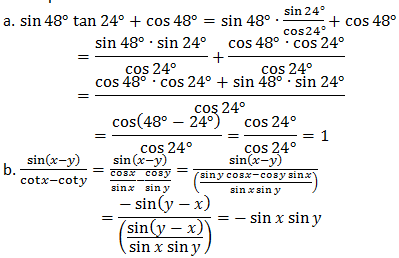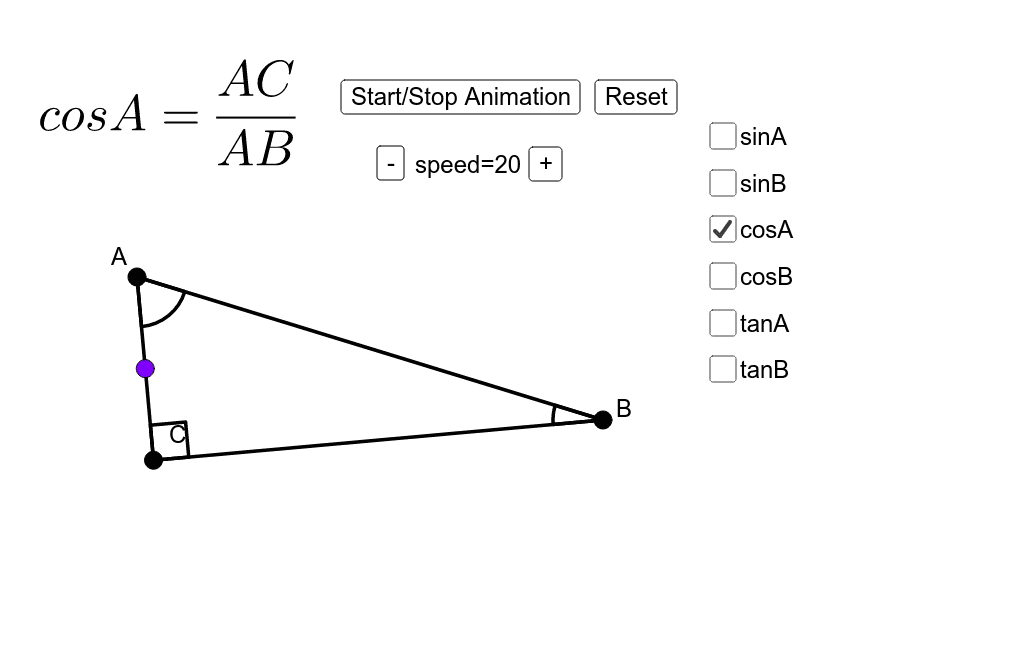- Cos is adjacent over hypotenuse. And tan is opposite over adjacent, which means tan is sin/cos. Considering this what does Sin Cos Tan equal? The tangent of x is defined to be its sine divided by its cosine: tan x = sin x cos x. The cotangent of x is defined to be the cosine of x divided by the sine of x: cot x = cos x sin x.
- The inverse trigonometric functions (sin-1, cos-1, and tan-1) allow you to find the measure of an angle in a right triangle.All that you need to know are any two sides as well as how to use SOHCAHTOA.
The best answer to this question depends on the definitions you're using for the trigonometric functions: Unit circle: t correspond to point (x,y) on the circle x^2+y^2 =1 Define: sint = y, cos t = x, tant = y/x The result is immediate. Point (x,y) on the terminal side of t and r=sqrt(x^2+y^2) sint = y/r, cos t = x/r, tant = y/x sint/cost = (y/r)/(x/r)= (y/r).(r/x) = y/x = tan t Right. Trigonometry Relations Calculator: This calculator determines trigonometry calculations (sin,cos,tan,csc,sec,cot) based on various measures that you enter. Simply enter the measurements you know and press the button. See full list on quickanddirtytips.com.
by M. Bourne
For the angle θ in a right-angled triangle as shown, we name the sides as:
- hypotenuse (the side opposite the right angle)
- adjacent (the side 'next to' θ)
- opposite (the side furthest from the angle θ)
We define the three trigonometrical ratios sine θ, cosine θ, and tangent θ as follows (we normally write these in the shortened forms sin θ, cos θ, and tan θ):
`sin theta=text(opposite)/text(hypotenuse)` `cos theta =text(adjacent)/text(hypotenuse)``tan theta =text(opposite)/text(adjacent)`
To remember these, many people use SOH CAH TOA, that is:
Sin θ = Opposite/Hypotenuse,
Cos θ = Adjacent/Hypotenuse, and
Tan θ = Opposite/Adjacent
The Reciprocal Trigonometric Ratios
Often it is useful to use the reciprocal ratios, depending on the problem. (In plain English, the reciprocal of a fraction is found by turning the fraction upside down.)


`'cosecant' θ` is the reciprocal of `'sine' θ`,
`'secant' θ` is the reciprocal of `'cosine' θ`, and
`'cotangent' θ` is the reciprocal of `'tangent' θ`
We usually write these in short form as `csc θ`, `sec θ` and `cot θ`. (In some textbooks, 'csc' is written as 'cosec'. It's the same thing.)
`csc theta =text(hypotenuse)/text(opposite)` `sec theta =text(hypotenuse)/text(adjacent)` `cot theta =text(adjacent)/text(opposite)`
Important note: There is a big difference between csc θ and sin-1 θ.
- The first one is a reciprocal: `csc theta=1/(sin theta)`.
- The second one involves finding an angle whose sine is θ.
So on your calculator, don't use your sin-1 button to find csc θ.
We will meet the idea of sin-1θ in the next section, Values of Trigonometric Functions.
The Trigonometric Functions on the x-y Plane
For an angle in standard position, we define the trigonometric ratios in terms of x, y and r:
`sin theta =y/r` `cos theta =x/r``tan theta =y/x`
Notice that we are still defining
sin θ as `'opp'/'hyp'`;
cos θ as `'adj'/'hyp'`, and
tan θ as `'opp'/'adj'`,
but we are using the specific x-, y- and r-values defined by the point (x, y) that the terminal side passes through. We can choose any point on that line, of course, to define our ratios.
To find r, we use Pythagoras' Theorem, since we have a right angled triangle:
`r=sqrt(x^2+y^2)`
Not surprisingly, the reciprocal ratios are defined similarly in terms of the x-, y- and r-values as follows:
`csc theta =r/y` `sec theta =r/x``cot theta =x/y`
We will see some examples of finding exact values in the next section, Values of Trigonometric Functions ».
Three Functions, but same idea.
Right Triangle
Sine, Cosine and Tangent are the main functions used in Trigonometry and are based on a Right-Angled Triangle.
Before getting stuck into the functions, it helps to give a name to each side of a right triangle:
- 'Opposite' is opposite to the angle θ
- 'Adjacent' is adjacent (next to) to the angle θ
- 'Hypotenuse' is the long one
Adjacent is always next to the angle
And Opposite is opposite the angle

Sine, Cosine and Tangent
Sine, Cosine and Tangent (often shortened to sin, cos and tan) are each a ratio of sides of a right angled triangle:
For a given angle θ each ratio stays the same
no matter how big or small the triangle is
To calculate them:
Divide the length of one side by another side
Example: What is the sine of 35°?
Using this triangle (lengths are only to one decimal place):
| sin(35°) | = OppositeHypotenuse |
| = 2.84.9 | |
| = 0.57... | |
| cos(35°) | = AdjacentHypotenuse |
| = 4.04.9 | |
| = 0.82... | |
| tan(35°) | = OppositeAdjacent |
| = 2.84.0 | |
| = 0.70... |
Size Does Not Matter
The triangle can be large or small and the ratio of sides stays the same.
Only the angle changes the ratio.
Try dragging point 'A' to change the angle and point 'B' to change the size:
Good calculators have sin, cos and tan on them, to make it easy for you. Just put in the angle and press the button.
But you still need to remember what they mean!
In picture form:
Practice Here:
Sohcahtoa
How to remember? Think 'Sohcahtoa'!
It works like this:
Sine = Opposite / Hypotenuse |
Cosine = Adjacent / Hypotenuse |
Tangent = Opposite / Adjacent |
You can read more about sohcahtoa ... please remember it, it may help in an exam !
Angles From 0° to 360°

Move the mouse around to see how different angles (in radians or degrees) affect sine, cosine and tangent.
In this animation the hypotenuse is 1, making the Unit Circle.
Notice that the adjacent side and opposite side can be positive or negative, which makes the sine, cosine and tangent change between positive and negative values also.
| 'Why didn't sin and tan go to the party?' '... just cos!' |
Examples
Example: what are the sine, cosine and tangent of 30° ?
The classic 30° triangle has a hypotenuse of length 2, an opposite side of length 1 and an adjacent side of √3:
Now we know the lengths, we can calculate the functions:
| sin(30°) = 1 / 2 = 0.5 | |
Cosine | cos(30°) = 1.732 / 2 = 0.866... |
| tan(30°) = 1 / 1.732 = 0.577... |
(get your calculator out and check them!)
Example: what are the sine, cosine and tangent of 45° ?
The classic 45° triangle has two sides of 1 and a hypotenuse of √2:
| sin(45°) = 1 / 1.414 = 0.707... | |
Cosine | cos(45°) = 1 / 1.414 = 0.707... |
| tan(45°) = 1 / 1 = 1 |
Why?
Why are these functions important?
- Because they let us work out angles when we know sides
- And they let us work out sides when we know angles
Example: Use the sine function to find 'd'
We know:
- The cable makes a 39° angle with the seabed
- The cable has a 30 meter length.
And we want to know 'd' (the distance down).
The depth 'd' is 18.88 m
Exercise
Try this paper-based exercise where you can calculate the sine function for all angles from 0° to 360°, and then graph the result. It will help you to understand these relatively simple functions.
Sin Cos Tan Practice Quiz
You can also see Graphs of Sine, Cosine and Tangent.
And play with a spring that makes a sine wave.
Less Common Functions
Sin Cos Tan Chart
To complete the picture, there are 3 other functions where we divide one side by another, but they are not so commonly used.
Sin Cos Tan Formula
They are equal to 1 divided by cos, 1 divided by sin, and 1 divided by tan:
Tan Cos Csc
Secant Function: | csc(θ) = HypotenuseOpposite | (=1/sin) |
Cotangent Function: | : Rolex Serial Number Verification
|